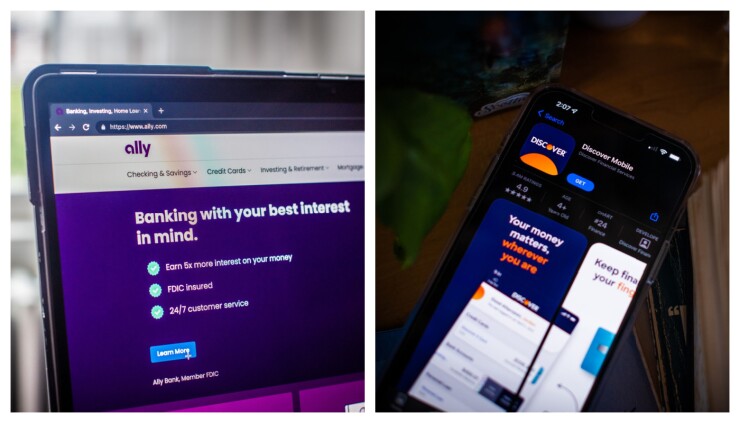
The war for consumers' cash has reached a detente, with banks taking a less aggressive approach to gathering deposits and starting to cut the interest rates they pay.
The rate reductions, which are providing some relief from what has been a bruising battle for deposits over the past year, are coming even though the Federal Reserve hasn't yet cut interest rates.
The latest action came at
Traditional branch-based banks are also shifting gears ahead of Fed rate cuts. Last year, they
"They don't see the need to be that aggressive," said Ken Tumin, the founder of DepositAccounts.com.
So far, the moves aren't all that big. High-yield savings accounts at large online banks paid about 4.43% on average this month, a tiny decrease from 4.49% earlier this year, according to a DepositAccounts.com index. Investors will get a fuller picture of deposit costs starting Friday, when banks begin reporting their quarterly earnings.
Online banks appear to be testing the waters and seeing whether they can lower rates just enough to save some money without majorly disappointing customers. Traditional branch-based banks have long relied on the "inertia" of depositors, who may not be willing to go through the process of shifting their cash to a higher-paying institution, Tumin said.
The "more mature online banks are in the same boat now," Tumin said, while newer online competitors are chasing after each other in the "rate-leader game." Several newer online banks still pay upwards of 5%, significantly above Marcus, Discover, Ally and others that have long offered high-yield savings accounts.
For some consumers, opening a new account at a higher-paying bank is much like driving 10 minutes to save a little money on gas, said Adam Stockton, head of retail deposits and lending at the consulting firm Curinos. Doing so requires research, transferring funds and keeping track of a new username and password, he noted.
Also contributing to the inertia is the fact that those customers may be happy with their online banks' services, he noted. Some deposit customers may have credit cards or auto loans with their online bank, or they may like certain apps or features that help them budget.
"Once people start using the tools and get everything set up and find a bank that they're comfortable with, then they do value the stability," Stockton said.
Online banks are also cutting the rates they pay on certificates of deposit, reflecting the less competitive environment for CDs across the industry. For one-year CDs, the average rate at prominent online banks fell this month to 4.94%, down from 5.35% in January, according to DepositAccounts.com.
Rates on traditional brick-and-mortar banks' CDs are falling a bit as well. It's yet another sign that the peak of rate pressures, when depositors were asking for higher payouts, has passed.
Last year, some banks acted defensively, paying up to keep their customers happy rather than see them head out the door — a prospect that became more sensitive after Silicon Valley Bank's failure.
Funding worries have since died down, but many banks still see a need to fight for deposits, since industrywide deposit levels have somewhat flatlined. Few banks are targeting double-digit loan growth these days, but they need fresh cash for those new loans they're making.
"There is still a need for deposits and concern about where deposit levels could go, which I think is part of the reason that we haven't seen very many aggressive rate cuts," Stockton said, noting that the moves so far have been "measured' and aimed at balancing deposit retention with growth.
One action that banks took last year to lock up much-needed deposits was offering CDs that lasted about a year — and paying rates of 4.5% or higher. Banks are now less interested in locking up money for that long at that price.
Instead, they're gearing their CDs toward terms of just a few months. That strategy gives them more flexibility to reprice CDs downwards if the Fed lowers interest rates this year, a prospect that remains likely, even though investors are increasingly calling it into question.
JPMorgan Chase, for example, is now paying a higher promotional rate on two-month CDs than on CDs of other lengths. Pittsburgh-based PNC Financial Services Group is focused more on four-month CDs, while Regions Financial is looking to draw in five-month CDs.
"They're getting shorter, which means that's going to cost them less," Tumin said.
In February, 72% of the new CDs that branch-based banks booked lasted less than a year, up from 37% a year earlier, according to a deposit tracker from Curinos. Very few banks want to lock themselves into long-term CDs at today's rates, with just 2% booking new CDs of two years or longer in February. The tracker analyzes data from 40 leading banks.
All the shifts in banks' consumer deposit strategies are aimed at protecting their profit margins, which have been "getting squeezed" for the past year, Stockton said.
Banks' net interest margins, which measure the difference between their interest income and interest expenses, have fallen as depositors seek higher rates for the cash they park at the bank.
Lenders have been able to blunt the impact on their margins by charging higher rates on their loans, but that revenue boost is diminishing at some banks. Many loans have already repriced to today's higher rates, and the modest loan growth that some banks are settling for this year will give them a smaller pool of loans to earn interest on.
Keeping deposit costs down is critical at this stage of the economic cycle, according to Stockton, since rates have flatlined and margins are under pressure.
"The end of a rising rate cycle has historically been one of the more challenging environment banks, and this is no exception," Stockton said.






